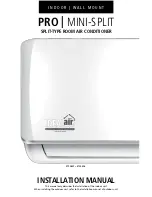
ii
2. The standards for minimum room volume are as
follows.
(1) No partition (shaded portion)
(2) When there is an effective opening with the adjacent
room for ventilation of leaking refrigerant gas
(opening without a door, or an opening 0.15% or
larger than the respective floor spaces at the top or
bottom of the door).
(3) If an indoor unit is installed in each partitioned room
and the refrigerant tubing is interconnected, the
smallest room of course becomes the object. But
when mechanical ventilation is installed interlocked
with a gas leakage detector in the smallest room
where the density limit is exceeded, the volume of
the next smallest room becomes the object.
3. The minimum indoor floor space compared with the
amount of refrigerant is roughly as follows:
(When the ceiling is 2.7 m high)
Check of Density Limit
The room in which the air conditioner is to be
installed requires a design that in the event of
refrigerant gas leaking out, its density will not exceed
a set limit.
The refrigerant (R410A), which is used in the air
conditioner, is safe, without the toxicity or combustibility of
ammonia, and is not restricted by laws imposed to protect
the ozone layer. However, since it contains more than air,
it poses the risk of suffocation if its density should rise
excessively. Suffocation from leakage of refrigerant is
almost non-existent. With the recent increase in the
number of high density buildings, however, the installation
of multi air conditioner systems is on the increase
because of the need for effective use of floor space,
individual control, energy conservation by curtailing heat
and carrying power, etc.
Most importantly, the multi air conditioner system is able
to replenish a large amount of refrigerant compared to
conventional individual air conditioners. If a single unit of
the multi air conditioner system is to be installed in a small
room, select a suitable model and installation procedure
so that if the refrigerant accidentally leaks out, its density
does not reach the limit (and in the event of an
emergency, measures can be made before injury can
occur).
In a room where the density may exceed the limit, create
an opening with adjacent rooms, or install mechanical
ventilation combined with a gas leak detection device.
The density is as given below.
Total amount of refrigerant (kg)
Min. volume of the indoor unit installed room (m
3
)
< Density limit (kg/m
3
)
The density limit of refrigerant which is used in multi air
conditioners is 0.3 kg/m
3
(ISO 5149).
1. If there are 2 or more refrigerating systems in a single
refrigerating device, the amount of refrigerant should
be as charged in each independent device.
For the amount of charge in this example:
The possible amount of leaked refrigerant gas in rooms
A, B and C is 10 kg.
The possible amount of leaked refrigerant gas in rooms
D, E and F is 15 kg.
NOTE
Outdoor unit
Refrigerant tubing
Indoor unit
e.g., charged
amount (10 kg)
Outdoor unit
Indoor unit
Room A Room B Room C Room D Room E Room F
e.g., charged
amount (15 kg)
Refrigerant tubing
Outdoor unit
Very
small
room
Indoor unit
Small
room
Medium
room
Large room
Mechanical ventilation device – Gas leak detector
40
3
5
3
0
25
20
15
10
5
0
10
20
3
0
Total amo
un
t of refri
g
era
n
t
Mi
n
. i
n
door floor
s
pace
m
2
k
g
Ra
ng
e below the
de
ns
ity limit
of 0.
3
k
g
/m
3
(co
un
termea
su
re
s
n
ot
n
eeded)
Ra
ng
e above
the de
ns
ity limit
of 0.
3
k
g
/m
3
(co
un
termea
su
re
s
n
eeded)
RoHS
· This product does not contain any hazardous substances prohibited by the RoHS Directive.
WARNING
· You are requested to use RoHS compliant parts for maintenance or repair.
06-405 Mini-ECOi_TD0 11/8/06 4:27 PM Page ii
Содержание SPW-CR365GX56
Страница 5: ...1 1 1 Outline of Mini ECO i SYSTEM Contents 1 OUTLINE OF MINI ECO i SYSTEM 1 Line up 1 2 ...
Страница 8: ...1 4 MEMO ...
Страница 322: ...4 180 MEMO ...
Страница 330: ...CN33 S003 CN51 CN50 D043 LED2 D042 LED1 S002 S004 5 8 Test Run and Others 2 Test Run Fig 5 10 2 for SPW CR GX H 8 5 ...
Страница 344: ...5 22 MEMO ...
Страница 345: ...200611M DC ...




































